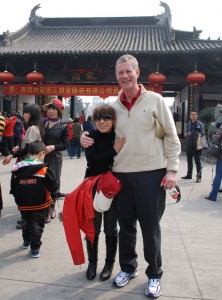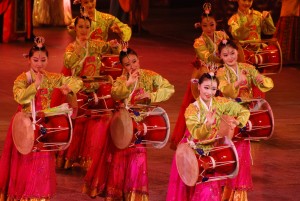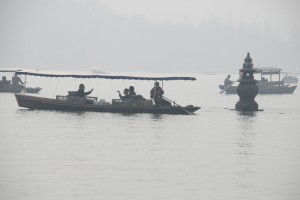West Lake, the Song Dynasty and Quite a Show
Before our delegation of scholars, executives and journalists gets down to business, Sunday afforded us an opportunity to learn more about the culture and history of Hangzhou and observe the beauty of our surroundings and of its people.
Among our offerings at the hotel’s breakfast buffet are salty duck eggs, fried rice cakes with mushrooms, dried spiced bean curd, won ton soup, bok choy and pumpkin and millet con gee.
We left our hotel on foot for West Lake, which covers three square miles and is surrounded by lush, green hills. Willow trees and other vegetation line causeways named for poets who lived during the prosperous Song Dynasty (960-1279 C.E.). Hangzhou was the dynasty’s southern capital.
When Marco Polo reportedly visited this place, he is to have described it as “the City of Heaven, the most magnificent in all the world.” In 2011, it remains captivating, although a combination of fog and pollution served to obscure its beauty somewhat.
We set out on one of the many boats which ferry passengers to Xiaoying Island, which consists of four enclosed pools and several pavilions. We are one of many tour groups on a pleasant March morning exploring the island, along with many families.
A key spot is where three lighthouse-shaped pagodas are located just off shore, arranged in an equilateral triangle, with each side 62 meters in length. Some believe the pagodas repel evil spirits hiding at the bottom of the West Lake, but a guide told me that they’re located near the lake’s deepest point.
As we return to our hotel for lunch, we walk not one, but two Kentucky Fried Chicken restaurants. One of many Starbuck’s locations also is nearby. These American icons are examples of how much the Chinese have embraced Western culture in the last 30 years. In another blog posting, you’ll meet Bruce Jaffee, director of IU’s Institute of International Business, who was one of the first American scholars to visit China in 1981. He’ll talk about the changes he sees.
Since this area is located along China’s east coast, seafood is featured on the hotel’s lunch buffet. We found shrimp, prawns, crab and sushi available. Back in Indiana, some menus offer frog’s legs. Here, we could try the bullfrog, which I found to be delicious.
By 1:30 p.m., we boarded a bus and went to a popular tourist destination, Song City. Dedicated the culture from the dynasty, this elaborate historical theme park is informative but was developed without any actual ruins or other remnants. A member in our party compared it to Busch Gardens in Virginia. Thankfully, though, there are no rides here.
People here recreate the folk customs of the era. We attended a wedding as it would have taken place in the 12th century. We climbed a steep staircase to look up close at a massive Buddha. We also see many children who remind some of us of loved ones at home.

R. Matthew Neff, president and CEO of University Health Management Inc., discovers his new-found celebrity and consents to having his picture taken
Although relations between China and the United States have been normalized since the 1970s, it is clear that some Chinese are still fascinated by Americans. A blond member of our group remarked how many times she attracted interest from onlookers.
And Matt Neff and I willingly posed for pictures, particularly for a pleasant and diminutive woman, who also wanted to be photographed with our entire group outside the park entrance.
The highlight of our visit to Song City, and perhaps the day overall, was the show, “The Romance of the Song Dynasty.” It is an elaborate retelling of the legends from this period in Chinese history, which involves a whitesnake, the battle to preserve the life of an emperor’s infant offspring and some fantastic dancing and acrobatics.
Cirque du Soleil has real competition here. There will be more pictures.
This evening, our gracious hosts at Zhejiang University hosted us to a wonderful dinner. I also will write more about the relationship between our two universities.
No Comments
No comments. Be the first.
Sorry, the comment form is closed at this time.



